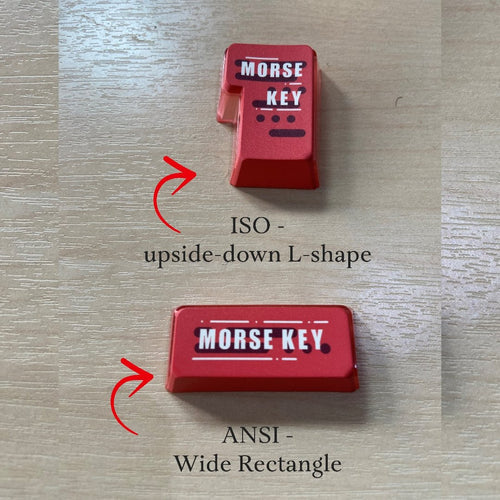If you are looking for a new mechanical keyboard, you might be wondering what are the differences between the ANSI and ISO layouts.3 These are the two most common physical layouts for mechanical keyboards, especially in Western countries. The physical layout determines the size and placement of keys, while the visual layout determines the order of alphabetical or numerical keys, such as QWERTY or Dvorak.

The ANSI keyboard is the most common layout overall, especially in the US. In contrast, the ISO keyboard is primarily found in Europe and elsewhere. In this article, we will discuss the main differences between the two layouts and why you might prefer one over the other.
The Main Differences Between ANSI and ISO Keyboards
There are five differences between the ANSI and ISO keyboard layouts. These differences involve the placement and shape of the:-
- enter key,
- left shift key,
- backslash key,
- right alt key, and
- alt graph (AltGr) key.
An ANSI keyboard features 104 keys in full size and 87 keys in compact form, while an ISO keyboard has 105 keys in full size and 88 keys in compact form (one extra).
-
Enter Key
On the ANSI layout, the enter key is wide and rectangular, whereas on the ISO layout the enter key is much larger and taller, shaped like an upside-down L-shape. The ISO layout follows the ISO convention of having an enter key in the third row, while the ANSI layout follows the ANSI convention of having an enter key in the second row.
The advantage of the ISO enter key is that it is easier to reach with your pinky finger and it covers more space on the keyboard. The disadvantage is that it reduces the size of other keys around it, such as the backslash key and the left shift key.

-
Left Shift Key
On an ANSI keyboard, the left and right shift keys are the same size, long and rectangular. On an ISO keyboard, the left shift key is about half the size of the right shift key (at about the same size as the left ctrl key). This is because of the extra key that is added next to the enter key on the ISO layout.
The advantage of the ANSI left shift key is that it is easier to press with your pinky finger and it covers more space on the keyboard. The disadvantage is that it might be harder to press with your ring finger if you use a different typing technique.
-
Backslash Key
On an ANSI keyboard, the backslash key is directly above the enter key at the same size as the right ctrl key. On an ISO keyboard, it’s directly to the left of the enter key at a smaller size. This is because of the different shape of the enter key on each layout.
The advantage of the ANSI backslash key is that it is easier to reach with your pinky finger and it has a consistent size with other keys on its row. The disadvantage is that it might be harder to press with your ring finger if you use a different typing technique.
-
Right Alt Key
The right alt key and left alt key are identical on an ANSI keyboard. On an ISO keyboard, the right alt key is replaced by the alt graph (also known as AltGr) key. This key enables users to easily type characters that have diacritics, such as á or ñ.
The advantage of the AltGr key is that it allows users to access more symbols and characters on their keyboard without changing their visual layout or using additional software. The disadvantage is that it might interfere with some shortcuts or commands that use
the right alt key on other layouts.
-
Number of Keys
An ANSI keyboard features 104 keys in full size and 87 keys in compact form, while an ISO keyboard has 105 keys in full size and 88 keys in compact form (one extra). The extra key is added next to
the enter key on the ISO layout to accommodate # (number sign) and ~ (tilde).
The advantage of the extra key is that it allows users to type these symbols without using shift or AltGr modifiers. The disadvantage is that it adds more complexity and inconsistency to the keyboard layout.
Why Do British or EU People Use ISO Layout?
The ISO layout is popular in Europe and elsewhere because of the inclusion of
the AltGr key and the larger enter key. These features make it easier for users to type characters that have diacritics, such as á or ñ, or currency symbols, such as £ or €. These are common needs in the United Kingdom and Ireland.
The ISO layout also follows the ISO convention of having an enter key in
the third row, which is more ergonomic and comfortable for some users. The ISO layout also conforms to the British Standard BS 4822, which defines the physical layout and labeling of keyboards in the UK.
The Difficulty of Finding ISO Keyboards and Keycaps
One of the drawbacks of using an ISO keyboard is that it might be harder to find than an ANSI keyboard, especially in the US market. Most keyboards sold online or in stores are designed for the US layout, which means that users who prefer the ISO layout might have fewer options or higher prices.
Another difficulty is finding compatible keycaps for customizing or replacing keys on an ISO keyboard. Keycaps are the plastic covers that attach to the switches on a mechanical keyboard. They come in different shapes, sizes, colors, and materials, and they can affect the feel and look of a keyboard.
However, not all keycaps are compatible with all keyboards. Because of
the differences between ANSI and ISO layouts, users need to make sure that
the keycaps they buy match their keyboard layout. For example, an ANSI enter key will not fit on an ISO keyboard, and vice versa.
Finding ISO keycaps might be more challenging than finding ANSI keycaps, because most keycap sets are designed for the US layout. Users who want to customize their ISO keyboard might have to search for specific keycap sets that support the ISO layout, or buy additional keys separately.
Thekapco: Your Solution for ANSI Mechanical Keyboards and Keycaps
At Thekapco, we specialize in a wide range of ANSI mechanical keyboards and keycaps. Whether you're looking for a full-size or compact keyboard, wired or wireless options, we have a variety to suit your needs.
We offer a diverse selection of keycap sets in different colors, materials, profiles, and legends, all compatible with the ANSI layout. Additionally, we provide custom-made keycaps that you can design to your personal preferences.
Our commitment is to offer high-quality products and services at affordable prices for all ANSI keyboard users.
If you want to learn more about our products or place an order, please visit our website or contact us via Instagram.


Comment3
Hi Dario & Irvin,
Thank you for reaching out! Apologies for any confusion. As this information is from older blog posts, we no longer support the ISO layout. Our keycaps are now primarily available in the ANSI layout. I hope this helps clarify things! If you have any other questions, feel free to let us know, or you can email us at support@thekapco.com for further clarification.
Same as Dario, your article specifies you support ISO layout. Do you still support ISO layout?
Because I was unable to find any ISO keycaps while browsing your website. The search bar didn’t help at all.
Could you point me in the right direction?
Thank you.
Hello,
I’ve read the article on your website that says you’re a specialised company offering a wide range of keycap sets that support the ISO layout. Looking at your website, I can’t seem to find a section or filter for ISO keycaps. I also looked at a whole bunch of keycap sets and none of them supported ISO. Could you please direct me to where I can view your ISO keycap sets?
Thank you